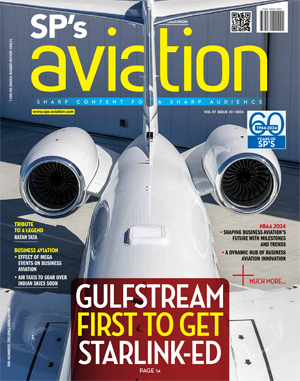INDIAN ARMED FORCES CHIEFS ON OUR RELENTLESS AND FOCUSED PUBLISHING EFFORTS

SP Guide Publications puts forth a well compiled articulation of issues, pursuits and accomplishments of the Indian Army, over the years

"Over the past 60 years, the growth of SP Guide Publications has mirrored the rising stature of Indian Navy. Its well-researched and informative magazines on Defence and Aerospace sector have served to shape an educated opinion of our military personnel, policy makers and the public alike. I wish SP's Publication team continued success, fair winds and following seas in all future endeavour!"

Since, its inception in 1964, SP Guide Publications has consistently demonstrated commitment to high-quality journalism in the aerospace and defence sectors, earning a well-deserved reputation as Asia's largest media house in this domain. I wish SP Guide Publications continued success in its pursuit of excellence.
Amend Measures

The DGCA directives appear to be targeting only the operators and passengers. The real solution lies in addressing the root cause of the problem—inadequacy of infrastructure.
The unprecedented boom in the aviation sector that began in 2004 propelled the airlines on to growth trajectories unknown in the industry. Annual growth of passenger traffic peaked around 37 per cent and stabilised at an average of around 25 per cent. Hit by global recession, the growth rate slowed down somewhat from the middle of 2008. However, the latter half of 2009 once again witnessed an upswing in the fortunes of the airline industry with the volume of traffic registering a respectable growth. At this point, all of India’s airlines inclusive of the national carrier appear to be well set on the path of recovery.
Unfortunately, when the airline industry was galloping, the government controlled aviation infrastructure was growing at a paltry 4-5 per cent annually widening the gap between demand and supply. The inevitable consequence of the gross mismatch was severe congestion and chaos especially at the metros and the old airports at Bengaluru and Hyderabad. Countrywide, the congestion led to interminable delays with cascading effect on schedules. On-time performance of airlines was indeed quite dismal.
With the commissioning of greenfield airports at Bengaluru and Hyderabad, and upgradation of the four metros progressing rapidly, there has been some reduction in congestion and perceptible improvement in punctuality. However, in an effort to obviate return of the malaise in the next phase of the boom in air travel, the Directorate General of Civil Aviation (DGCA) in October 2009 issued the Air Transport Circular 10 of 2009 defining a series of steps to ease congestion at airports beginning with Mumbai and Delhi. These two airports together handle a major share of the air traffic in the country and are relatively more vulnerable to congestion-related delays. As per the circular, the check-in counters are to close 40 minutes prior to the scheduled time of departure (STD), as against the norm of 30 minutes. Airlines have the flexibility to advance this further and passengers are now being advised by some airlines to reach the check-in counter two hours before STD.
Also, the aircraft engaged in domestic operations would be required to contact surface movement control at least 15 minutes prior to the STD for push-back and engine start. As it would take approximately 20 minutes to embark full load of passengers booked on an Airbus 320 class of aircraft, boarding would have to commence at least 35-40 minutes prior to STD. Besides, if the commander fails to adhere to the 15-minute deadline for moving out of the parking bay, the departure would be put on hold and rescheduled by 60-90 minutes. For passengers who have already boarded the flight, the rescheduling would translate to an excruciating delay that one would have experienced on account of congestion.
The Air Transport Circular 10 of 2009 though issued in October 2009 but implemented only in July 2010, militates against the low cost carriers (LCC) that aim for a 30-minute turnaround and optimum utilisation of the aircraft in a 24-hour cycle. The circular obviously did not take into account operational imperatives of the LCCs. The airports where the new directive is being implemented are Mumbai, New Delhi, Bengaluru, Kolkata, Hyderabad and Chennai. In the new terminal T3 at the Indira Gandhi International Airport at Delhi, passengers will have only 25 minutes to transit from the check-in counter through security check to reach the farthest boarding gate. However, practically, a normal able-bodied adult passenger would need at least 30 minutes for this journey at a comfortable pace. Clearly, under the new dispensation, the exercise of boarding a flight at the major airports with the check-in procedure afflicted by archaic methods and practices is going to be a mad scramble even for a physically fit individual. The circular has also placed debilitating restrictions turning business aviation at the major airports into a nightmarish experience.





